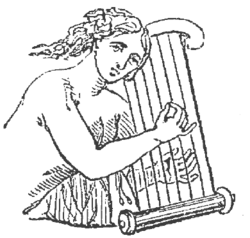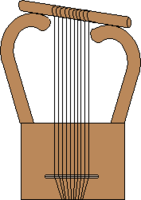| Revision as of 06:55, 28 April 2024 editElias Ziade (talk | contribs)Extended confirmed users, Pending changes reviewers25,672 edits removed Category:Phoenician musical instruments using HotCatTag: Manual revert← Previous edit | Revision as of 07:20, 28 April 2024 edit undoElias Ziade (talk | contribs)Extended confirmed users, Pending changes reviewers25,672 editsNo edit summaryTag: 2017 wikitext editorNext edit → | ||
| Line 8: | Line 8: | ||
| |related=], ], ] | |related=], ], ] | ||
| }} | }} | ||
| The '''nevel''' |
The '''nevel''', '''nebel''' ({{lang-he|]}} ''nēḇel''), was a ] used by the ] and the ]. The Greeks translated the name as ] (νάβλα, "Phoenician harp").<ref>], '']'' </ref><ref name=OED>{{cite OED | nabla}}</ref><ref>{{cite book |author=Rich, Anthony |title=A Dictionary of Roman and Greek Antiquities |url=https://archive.org/details/adictionaryroma01richgoog |location=New York |publisher=D. Appleton & Company |year=1874 |page= }}</ref> | ||
| ] showing lyrist, excavated from the same site as the ].]] | ] showing lyrist, excavated from the same site as the ].]] | ||
Revision as of 07:20, 28 April 2024
 Ancient Nevel (Harp) Ancient Nevel (Harp) | |
| Classification | String instrument |
|---|---|
| Related instruments | |
| Lyre, Kinnor, Kithara | |
The nevel, nebel (Template:Lang-he nēḇel), was a stringed instrument used by the Phoenicians and the Israelites. The Greeks translated the name as nabla (νάβλα, "Phoenician harp").


A number of possibilities have been proposed for what kind of instrument the nevel was; these include the psaltery and the kithara, both of which are strummed instruments like the kinnor, with strings running across the sound box, like the modern guitar and zither. Most scholars believe the nevel was a frame harp, a plucked instrument with strings rising up from its sound box.
The King James Version renders the word into English as psaltery or viol, and the Book of Common Prayer renders it lute.
The word nevel has been adopted for "harp" in Modern Hebrew.
See also
References
- Athenaeus, Deipnosophistae 4.174
- "nabla". Oxford English Dictionary (Online ed.). Oxford University Press. (Subscription or participating institution membership required.)
- Rich, Anthony (1874). A Dictionary of Roman and Greek Antiquities. New York: D. Appleton & Company. p. 439.
- Joachim Braun (2002). Music in Ancient Israel/Palestine: Archaeological, Written, and Comparative Sources. Wm. B. Eerdmans Publishing. p. 23. ISBN 978-0-8028-4477-4.
- Neil, James (1913). Everyday Life in the Holy Land. London, UK: Cassel & Company, Ltd. p. 218.